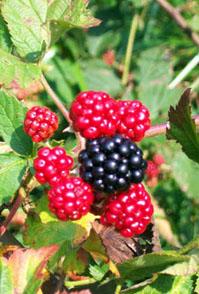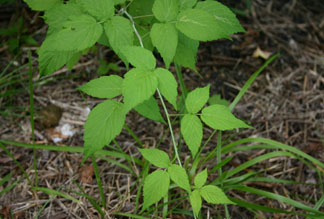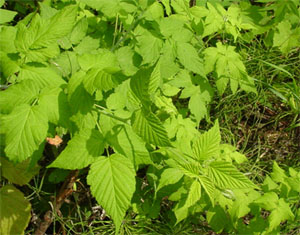BLACKBERRY

– Rubus procerus / ROSACEAE Rose family
Other Common Names for Blackberry: R. procerus: Himalaya Blackberry, raspberry, blackcap
The blackberry is a widely spread wild food that is easily identified. Not only are the berries edible but the leaves can be used in teas and infusions.
Description:
Blackberry can be a Shrub or bush-like perennial, can have trailing or climbing canes (most usual), thorned or smooth (usually domestic varieties). Blackberry leaves are simple and lobed to compound. Blackberry fruit is a berry generally in multiple drupelets. R. procerus: Bushy, large, dense clusters; stems stout, multiple, arching, thorned, up to 10 m long. As can be seen in the picture, blackberry leaves are divided into 3 or 5 leaflets, sharply toothed, 1.5-3.5 cm. Typically the fruit is black when mature. The flowers of blackberry generally are small and white. Bees are always active during flowering. Once flower petals drop fruit begins to develop. Unripe fruit looks segmented and like small examples of ripe fruit only white in color.
Location:
Blackberries are found throughout North America, generally in uncultivated and burn areas. Their habitat is extremely varied. Many times along roads or on the edge of border areas. This is one of my favorite wild fruits to pick while out on hiking or fishing trips.
 Season: Blooms in spring and early summer; fruit late summer and autumn. On of the earlier thorned stems to leaf out in the spring.
Season: Blooms in spring and early summer; fruit late summer and autumn. On of the earlier thorned stems to leaf out in the spring.
Edible:
Young shoots in spring; berries ripen in late summer and autumn. The fruit can be very seedy so be careful.
Preparation:
The young shoots can be cut just above the ground, peeled and eaten raw or cooked. Beginning in late summer the berries of most species are available. The berry can be eaten raw, boiled down to a syrup, squeezed for juice, cooked with stews or made into preserves, pies, and even wine. Leaves can be dried and used to make a tea substitute.
Growing your Own:
Blackberry plants are fairly easy to grow. I have gone from “stealing”  wild cane to buying from a garden center. My experience is that domestic varieties are juicy and sweet while wild blackberry is sweet but rather seedy. The only wild blackberry I ever really liked as much as a quality domestic were the blackberries in the Pacific Northwest – Oregon and Washington. Anyway, I would suggest buying your plants from a quality supplier like Burpee. The blackberry should be planted late fall or early spring with room to grow and in a place where ‘pretty’ isn’t super important. The plants will spread through shallow runners. You will need to control the spread by planting in a raised bed or by routinely digging them out.
wild cane to buying from a garden center. My experience is that domestic varieties are juicy and sweet while wild blackberry is sweet but rather seedy. The only wild blackberry I ever really liked as much as a quality domestic were the blackberries in the Pacific Northwest – Oregon and Washington. Anyway, I would suggest buying your plants from a quality supplier like Burpee. The blackberry should be planted late fall or early spring with room to grow and in a place where ‘pretty’ isn’t super important. The plants will spread through shallow runners. You will need to control the spread by planting in a raised bed or by routinely digging them out.
After harvesting your crop, it would be smart to treat the plants with a preventative general purpose fungicide. It should help to prolong the life of your patch.
Other maintenance is cutting old canes (big brown) or dead canes back after fruiting.
Notes of Interest:
Noted for its sweet delicious taste. The berries and root have medicinal properties useful for treating diarrhea. Blackberries and strawberries are very high in ellagic acid which is an antioxidant.
Try our blackberry recipes
If you want to grow your own blackberry patch – use a quality company such as Burpee